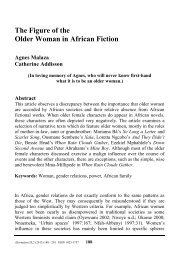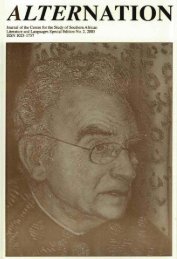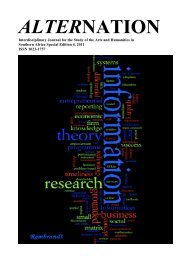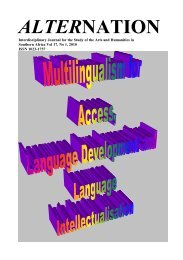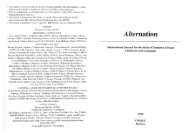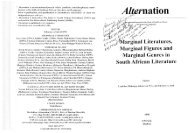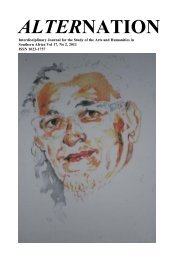Shane Moran - Alternation Journal
Shane Moran - Alternation Journal
Shane Moran - Alternation Journal
Create successful ePaper yourself
Turn your PDF publications into a flip-book with our unique Google optimized e-Paper software.
Alex In Gzlrna i Polltics and Aesthetics<br />
Republic' as a precondition for the realization of socialism". La Guma's analysis of the<br />
South African situation received the blessing of the executive of the Comintern, which<br />
then submitted tlie adoption of the slogan, '[aln independent native republic as a stage<br />
towards a workers' and peasants' government with full guarantees of the rights of<br />
minorities' for discussion by the CPSA (La Guma n.d.:48). This proposal was,<br />
however, vehemently rejected and criticised by some members of the party, with S.P.<br />
Bunting being the most vociferous. After a lengthy debate amongst members of the<br />
party in Cape Town, the 'Black Republic' thesis, as it was later called, was endorsed by<br />
the CPSA in 1929. Commenting on La Guma's pivotal role in the formulation and<br />
subsequent adoption of the Black Republic policy the Simonses (1983:398) argue:<br />
Only a person who cotiibined a firm adherence to Marxist tlleory with a<br />
passionate belief in national liberation could conceive the prospect of African<br />
rule as a necessary first stage to the achievement of a classless society. Such a<br />
person was James LaGuma.<br />
The Black Republic thesis, which was based on Lenin's 1920 thesis on the national and<br />
colonial question, in terms ofwliich the national liberation struggle against iinperialism<br />
is seen as tlie first stage towards socialis~n, was to have a profound impact on the<br />
relationship between the AfricanNational Congress and the South Africa11 Communist<br />
Party (as the CPSA was later known) at a later stage in the history of the struggle. For in<br />
the words of Francis Meli (1989:79), it underlined the crucial<br />
relationship between African nationalism and socialism. by stating that tile<br />
concept of class struggle must of necessity inco~poxate the principle of<br />
national self-determination for Africans and othcr nationally oppressed<br />
blacks.<br />
"<br />
Jack and Ray Siruons (1983:398i) sun1 up La Guma's argunxnt in tlle following works:<br />
'First establisll majority rule. he argued. and unity. leading to socialism. would follo\v'. The party<br />
should therefore concentrate on strengtllening the movc~nent for national liberation. and at tlie<br />
same time retain its separate identity and rolc as a socialist party. Co~n~n~~nists should 'build up a<br />
mass party based upon thc non-European masses'. unite landless whites and natives behind an<br />
energetic agrarian policy, give expression to the demands of African workcrs and dispel their<br />
illusions that the British acted as the demands of African workers and dispel their illusions that<br />
the British acted as intermediaries between them and their Afrikaner oppressors. The 'native<br />
republic slogan would act as a political catalyst, dissolving traditional s~ibscrvience to whites<br />
among Africans and racial arrogance towards Africans among whites'. The phrase 'dissolving<br />
traditional subservience to whites anlong Africans and racial arrogance towards Africans among<br />
wllites' immediately calls to 11iind Stevc Biko's assertions in I Write Wl~zt [Like. It is perhaps such<br />
statements in James la Guma's argument that promptcd Joe Slovo's conclusion that tl~c Black<br />
Republic tllesis foreshadows Rlack Consciousness in SouthAfsica [Amakomanisi:The Soutll<br />
African Communist Party 1921 - 1986 (video cassette)]. 'The ideological thrust of the 'Black<br />
IZepublic' thesis is, llowever, difrerent froln the iernls of UlackConsciousness.<br />
bulnni Mkhize<br />
st significantly, the 'Black Republic' thesis, which underscored the collaboration<br />
tween British imperialism and 'the white bourgeoisie of South Africa' (Bunting<br />
:91), was a precursor to the 'colonialism of a special type' (CST) theory, which<br />
ed the central thrust of 'The Road to South African Freedom', the programme of<br />
outh African Communist Party (SACP) adopted in South Africa in 1962. In terms<br />
the CST theory, 'the oppressing white nation [occupies] the same territory as the<br />
pressedpeople themselves and [lives] side by side with them' (Bunting 198 1 :299).<br />
111 the words that clearly signal the official justification of the alliance between<br />
SACP and the ANC, the programme also states that the South African Communist<br />
rty set out as 'its immediate and foremost task' the attempt to work for aunited front<br />
national liberation and 'to strive to unite all sections and classes of oppressed and<br />
mocratic people for a national democratic revolution to destroy white domination'<br />
unting 198 1 :286). James La Guma's position is clearly indicated in the following<br />
ords which conclude the introduction of the programme:<br />
The destruction of colonialism and the winning of national freedom is the<br />
esseiltial condition and the key for future advance to the supreme aim of the<br />
Communist Party: the establishment of a socialist South Africa. laying the<br />
foundation of a classless, communist society (Bunting 198 1 :286).<br />
The Simonses (1983:450) refer to La Guma as 'the chief architect ofthe black republic<br />
policy': this intellectual role which clearly underscores his highest achievement as an<br />
'organic intellectual', was bound to have a significant influence on his son, especially<br />
with regard to his perspective on national liberation and class struggle in South Africa.<br />
early activism<br />
As can be seen, then, Alex la Guma was born in a home where working class polltlcs<br />
and the national liberation struggle were a major preoccupation, and was encouraged<br />
from the beginning to think in class terms and to see the situation of Coloured people m<br />
the national context. At one level, it was the existence of 'an atmosphere of working<br />
class activity and ideas at home' (La Guma 1991: 16) which aroused La Guma's<br />
curiosity as a child and helped develop his political consciousness:<br />
I do not remember my parents ever sermonising me as [a] child, but one was<br />
always being advised to devote oneself to 'sometl~ing useliil'. or 'to lead a<br />
useful life'. A picture of Lenin hung in our living room. Very oftz~i people<br />
came to visit and1 would hover on the outskirts of the conversations, listening<br />
to chats about politics, tl-ade-union work, or the 'Party' ('Gala' 1982:jO).<br />
La Guma recalis enqulrlng from hts mother about the picture of L,enrn on the~r l~vrng<br />
toom wall and be~ng informed that h ~s father was 'a followe~ of L,en~n' and that 'I en111<br />
had been the leadel of the great change 111 Russla wh~ch had done away w~th poverty so<br />
tl~t people no longerneed to he pool ' Whcli he pr obcd f'~n the^, i a Gurna goes on to tell<br />
us, hls mothel told h11n that '[hrs] father and others l~ke hrm used the teach~ngs of Len~n



